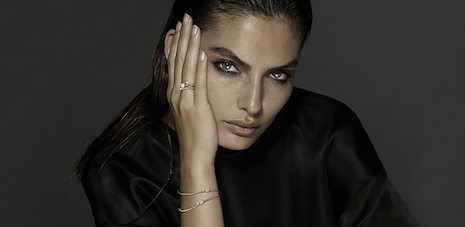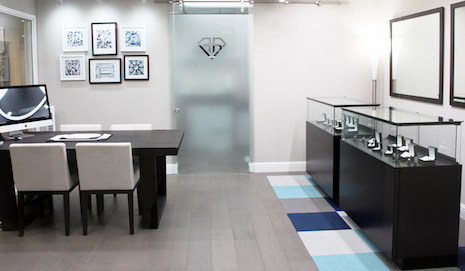Mined diamonds are facing increasing competition, as two-thirds of millennials who are shopping for an engagement ring are considering lab-grown stones.
While only 9 percent of consumers knew about lab-grown diamonds in 2010, today more than half of shoppers are aware of these alternatives. According to a report the International Grown Diamond Association commissioned from MVI Marketing, about a quarter of millennials are planning to buy lab-grown stones, looking to get more bang for their buck.
"Based on the research and the actual activity in the retail jewelry channel, we are seeing a strong growth in consumers being interested in and purchasing lab-grown diamonds," said Marty Hurwitz, CEO of MVI Marketing, Austin, TX. "Retailers showing both lab-grown and mined diamonds to consumers are able to present a larger lab-grown diamond for the same price as a smaller mined diamond.
"This choice is very compelling," he said. "Retailers are reporting a 60 to 70 percent close rate for lab-grown diamonds versus mined diamonds."
Growing awareness
Awareness of lab-grown diamonds is highest among millennial consumers. This age group also shows more positive feelings towards lab-grown stones, with 84 percent looking favorably on them.
Sixty-three percent of millennials also know someone who already owns a lab-grown diamond, compared to only 28 percent of non-millennials.
Consumers show the most awareness for the brands Diama by Swarovski, Brilliant Earth and Diamond Nexus. However, respondents were most apt to say they are unaware of any brands, creating an opening since there is no clear frontrunner in the category.

Diama by Swarovski. Image credit: Diama by Swarovski
"Celebrities are wearing jewelry with lab-grown diamonds and well-known designers are developing new styles regularly with lab-grown diamonds," Mr. Hurwitz said. "Both of these influencer groups are having a major impact in driving organic awareness with consumers.
"However there is a lack of macro marketing to consumers as yet," he said. "Organizations like IGDA will be developing integrated marketing campaigns to bring lab-grown diamonds into a greater level of awareness with consumers."
Male millennials show more of an interest in purchasing lab-grown diamonds, with 25 percent planning to buy created rather than mined stones for engagement rings, compared to 19 percent of women.
Lab-grown diamonds often cost less than mined stones of the same carat size, allowing consumers to get more for the same price. Consumers actually expect lab-grown stones to be 20 to 40 percent less expensive.
In the study, consumers were asked to pick between sets of stones that were identical in size and quality, and 70 percent of participants picked lab-grown stones due to a price difference of 25 percent.

Brilliant Earth's collaboration with Lela Rose. Image credit: Brilliant Earth
Sixty-three percent of consumers would choose a 1.9-carat lab-grown stone over a 1.4-carat mined stone if the price is equivalent.
Consumers also show a tendency to pick lab-grown stones if they can get better cut, clarity or color at the same price. Bridal shoppers show even more likelihood of picking the created stones for these attributes.
About half of consumers say they were not shown lab-grown stones as an option. A third say they would have bought created diamonds if they were shown pieces.
Some lab-grown diamond creators have taken retail into their own hands. For instance, Ada Diamonds opened a showroom in San Francisco to give its diamonds a bricks-and-mortar presence (see story), and Brilliant Earth has showrooms in a number of U.S. markets.

Ada Diamonds showroom. Image credit: Ada Diamonds
Even when buying lab-grown stones, consumers overwhelmingly want them certified. Only 4 percent felt it was less important to have a lab-grown diamond certified than it is for a mined stone.
Beyond bridal jewelry, about two-thirds of consumers are interested in lab-grown fashion jewelry.
Even though lab-grown diamonds are growing in awareness and popularity, they still make up a small piece of the global diamond business, weighing in at most 3 percent. Citi has made one of the highest projections for lab-grown diamonds, which it says could make up 10 percent of the market by 2030.
Diamond developments
British jewelry group De Beers’ introduction into the synthetic diamond market could shift the industry to become more widespread, but it will also likely impact it in unexpected ways.
De Beers began offering a line of lab-grown diamonds starting in September under the name Lightbox, but its prices are listed far below competitors'. The low price point will allow the line to become widespread but positions synthetic diamonds as far below natural diamonds (see story).
Lightbox has recently aimed to increase awareness through pop-ups that center on engagement and education (see story).
Aside from price, one of the reasons that consumers choose lab-grown stones is the ability to know their provenance. But mined diamond companies are pushing into a more open dialogue about diamond origins, aiming to assuage concerns.
U.S. jeweler Tiffany and Co.’s heightened push to be transparent with diamond sourcing exhibits just how important ethical gem origin is today, and why brands need to let customers know where their jewelry comes from.
Tiffany is taking a large step in revealing where its diamonds come from in an effort to be more transparent with its customers and better serve the ethical-focused consumer of today. Through social media and greater product details in addition to more ethical services rolling out in the future, Tiffany is hoping to solidify confidence for customers when purchasing with its brand (see story).
"Millennials are driving the growth in the lab grown category," Mr. Hurwitz said. "They are supporting the eco-friendly aspect of this product, and they are sharing their learnings on social media."
{"ct":"aGegJqFX7xufbgGhuqcLfAFsVGq9opetQG6lYBwqv\/fnVXOHE4+6MadJgZT+hDQa7GVNNTTDge6s\/YBc9\/qCafKh4CvvmsSwbH9Rl3ffN3LBCpCZkcwqJA15GpUX3Ddf0WkOonKsrF\/3Ap+5VMCF9oxXbFrwGEBwmyZP+cCTqeXsnzhGyJpc689702pJkBb3qd12t5JEw+YHffqfU7v9bYN5PMsBSYS7SCAvGT46kUrrSAz7BNADnEmpug0vsNpitb7R0QiWAJBDhiZ42+v0lZaPydTxQjE+C5R\/sp+VC55pR1mHzG\/fHbbjT19xW+ipqRtPs7f+W15mNQdxdealsH07mMqXb9OB00T2vzuPk3Ii008kLnvC\/H27ASm3kFVC313l9JFL7tjahSojXMIyixber4Wl1zQnilRKRjkSGSIUPcECPI\/tfUsnqjglFmakyAYC0R7ig47V4Wi5xeaX84eOVds4y1JCCCNYYDBypQpm9JlX4Svic4EwUd4\/Es+apgb+z2mrKR1+gPYqgXfkxAtqMZY215xOSeQ0oQ1EDPHQ4l+9LQk93BzzIbxDQH1MzOxdDtNF\/gjl4RGEqVBD3rAD+AkapXbdmAkMUFc7awGs79DrSHS68ARvdew0DahDD4uzQofOzmT0eVrzYk+YGuoew3O8PnljD1W+Qaqmv+ju9vwYO38xrdxBP48Ejif\/oV\/\/C7NyMLyAzCdVDHH1UvXY8kTtlvo1UwmScAQOfvQnH+XqGNRnyaiQ6UluMeLfYckVUNtVkPSXBZa6QPRr5rodcWrNCmu2k60eyOdK6oQGY4kIK0cl+IT89sjqeVZ2iT1mmkPFrJ7tIFqm50b49To\/Oowfjt0ymVgzMLHG0ZqRDRvONyX+Bp11K6FsgYnu4BQW2aKhTZsqyH\/3oSpH1px8hGauYW4\/doNZMUDmxzdOLGu9lxqHg3bMEEL9CabyXZLkgdpdBd\/L5CuFV+HZcnw58NjbJLsXEC+XOD+w2J\/aQgOn7VVtOOSD\/dUAM+7XvZSRU\/\/7N4C5LSIDLp4CBDGbd7WpjDvedvBgEReImJON8HVwZNDSiNw5mVRITcxecA92HgbVO8M3\/eGFXIdmM+28fFX9iPUhbc5Gumi5Hz3XhDcDX52biWbMZ\/3wm0WtWbJxh\/ESGLOZlN7FJ\/OtJVUDycVkKKAaCWibODaatrnwqzrUMSeWltxPsxMN0k3Y5+sN5AAsV+\/99zezPCSkYMk0Ywj0jrpdRCM3E7K2X2aM80\/D1HQAjm9mN8rlLXWr1KeUH5HjA3pTZacfvzrEB9tuHLCQVfNZ9DlNr6xL+9JF46x2pbbSwU0\/YouQr7ZH0pJuq\/dnF4dPa0eqJXrK89MmVdrSvYGOlcyY3s5F+ahb2JdirDueHKKm0M682\/meV6NmBlBBX+hN1ZhTKw0xErqMkYDxjHUwTBLOrCCh3NkMmrMfbRJn8RFJLl9wvq0tN0W8LCDk3159xlUzHjmSLpOnHs1BSiyZxtfvl9eN5k4ahsN7rt9ShMBhJ2DCWC9jS0HEk9\/adpIHvDee3o33vFCJ2\/9\/Xb8ObQQhDKZWimk0+LO7kQUw2J8bKthRBVTuKIFFXDiFf\/yvUiD1tFF4e+IDFUaMJiWV+hxg689jg9JP2vqfkga7Nb\/RDh\/+rll3LrOU2zyAXqTS5NUI795vvGXQ8AcEbss1YKGRrgAlCrR\/cj+3cUSf1x9jVQSxPLKarDnb5CJJnOJYejE+gU1Bd9j0YJWI35VyQdSbNCBr1+J3bmAOOYGdJ2X8mVC0bSozldwhYA0\/np8eSgek15Q0edDWZvXrbFsWGI8ckL1RTC+2jBvk8EIIQQUQJHAcVwtG+q0Qpxe2UfO8xCZ53IlY4419mqZVvkMTkkUsDIW5Fd7ZvqJnYfWzoqTYUsEEZg4prxSseccw4nxcSrnWxlNrH82LzGffA8FnWoEMCQtNpMn\/b1H2exm92c4mr3kIdcG54WOcBKlKOjkDbXovj1eJyJUTSGPhU6JoHOmM1QJz0MLOUp9vLMaDkkakD+qrbe09k30jzxFBQR+2Mi5Ir3li5ZlYNc1x2nXJSNqTESKdtfINh5YL5VlwP\/MgqeneVR03DD7aG5Z25XvzBMcZ5cQL1szN7V4RmQHg3YJS\/iELgmakLg4UwRtHpFPLnqOvXSZTx7bE4IAp92q8nNYhVfj9l6K34Kcfjv8Oc7CO13WqX4kzIOYTL4U79oFeRGqrApY8gI4JE1nfqJTxokD9WJio8GTkHG6M+Gjo5MjHiy0nD9ArUVWCDOBUXcx5AM\/5NaYDiDY9RV2bi7z+rQaSMz\/1YyE+M8xyTE39\/ahaSvqIwHYtq+1Oulw\/OxnAwLe6\/23SPdNzLsUe73AZIwEHV278q9WmX9ElPyf0VB5z1p6oTMJD20wmUtTKYJ5Dg0K+6Q+i5Cos4ipIAXRJAOKfvNaZSIb5ofkjt96BMNaxueyRXmPoB8Hf\/7U0VN3Cxs2EnglJoOCeJgPfOk+U8eg\/qm6S4qu\/SsWwJP3KZaHqINNLxcyftoF06pJKWEumeiWDKRFRufVa4PuLdjmIWMsCNdL5amvxauSTVUQ+5f5yMxADh\/ccDTe1AABL6T4qac2dqNVpu9JEmd2qZ+AItOn8JJ7V2F1P1Mxqbk3XgvVxEneV0KGAbrqzOuEgdFsdSpTNOLOVq\/aGfVdUBqPBsAM1nFy4YAxvAv4tRveunbmUsoEDZAqeX6qVfp+cs6U+s+O0fte2IkLuAjRb7bSSRStidyVhtdMkZ2UKYFSuNFx\/B\/9cAJrIz8ZsFbwSF9xbQPl6LJ\/xCtMArNs23W9OqEttKTTvoWsMsyyg6l7scfIkQrKus3BpCqhLHyaF+OntGEOnb0BhFCkPmzUtXO7O4g7VO4rqMOp8xiuCmqEMRml0ZCxXchs4HPq739VMHU5UY8XxKKF+2Oxddn9p9cCJbxND8LsOXQBOGBxcHsA\/DzXtzEHFx952Bu7qoc3HEOLTHyRhifTgXx5THECKqH47IOYjG15aqr49BoKWK5aNwxI4R+6H+YqQZyTYLQXYNbLXwJTUgbNRDT2SHfcPkPfxUWk33WU7dlvWt3YQJZEPm9cVrSH9AlemT4lsq39PoDo+WaycWQN4E\/jQRvjgChheUW0j2l7GEtI8bvTwA55cDwDNEdIS6fCGeuZ2l\/WT58KWZFojVtWng00BsmBtnmM9PT\/BIAzAUi3ygiaNlrvRIkdvtawedInC1dbKQCD5kWTsdqzf8ByBepj0Ddu1H\/LzR8gdn4KVViuVMnAAyFbvBWSwjZI3lI7jLXXzhQNm42wyGWFGTtdJvPmmEr6Ieo0KKMP6IABjhg6JrGWVNdHf9mWdEltaJUx8vtSra06+bDJEzfPDnQkwa9Qth3HUWdM+0mJQ\/aW87HKBhSiDw3eZJ2jZnPUhWKpU1oNMt0bo1KIhkBVh5yXKYSc4yxLDkL+q6hr7hZis0mche7phU432XBre4St\/R1SJqkbzev4Ktj\/Uofw9gFQ71CzEIGw57WL36sOufSI5igEve9sfoyvK5xamM+5+c747xfOMaXdeaWuYtBUHJ7gN3awMdk92zDp7BjFWZA5GcumwudSnb4gdTKR+H8\/7zTOUB83JAAajs7kuGWBftWoYSqfavuEyo8gwpBjf36HeKgKzHXiK9LKjDgxZ\/yb2+geByimgwuFSw533apT\/U7y2gl26uRkTZ56x+kVUmfP7DOd8jLSq6AKDBNCKQNl5XhreyVDLy9lyLVHnMkfRc62OFp+TKLK5uR8lDwMBK5TOgfT6t8U5uZikUxjGO0KNqI0c32ilrXYvcQLtVVkLNLSa+v3tUVmesXlsPIxMhoMLCB\/x4+QiDfQhIoPpYuQMnSJnIgcn0+SyAnJY9+8FNZN8LM3FAsogfnFGSOWg\/qSmOd8w5\/chzTuLe1cAxts8bVlIi7xaf63stZ+T7bAWDuV7a2\/vs+A5X5oPO8+d1DQr0QJBZAIUbeBhgorVRTzX8uV8TMo8HlWKBQ1W1W8cYuBInF5qXacqEqkfC0wTOjaLNXYWQlqDBfi4TTIZHD4iX522l9XWrLSW7m6gnEPZEukz8T636WZlsE8o1lSE7Npbwr4JSTlAbkLq3jfbUVVXs3toxJ+WO+JDiym3MM1BIaajPJziGKrsE3kOwDhpF6\/6UcLc4U0J5Ba90HlpZKJ1mU1khYpjAnvX+iZDa3HQp5JP+bd6L4BZ0RIZhu\/FrObg1ClDwKEuHKnlXuJThLPB2EX7w6zL+C1AMiVLKN3QKqNOWIi48Cx7rEF6Hy0cBL9cIbWHaUmn1G2eiM8vHZfvRtiEFkNt6ZrekCxWhzP1YcCur561TPzCt9HECGtRuyvB8xVp2zO55H0NGjEZQ3rje5y9ZKh5QvXhI7ktdxuYIcg\/Ukr\/TThanKDOt07Id96VQZFz4Wpwqj4jZxcJGyWvvw8wHcTU+jCICVHxGDx6ItJEADwIvSC8W24vL+AB52mcoQ1Axp2C2bSMIs7nVST6M4isim26tYaFpAep3asbh3HQkiKm2YVmqlq4Xsn8I5ZYMTBpdC1X8KamSIcqSuMoY0kN2GPjonfXw40z7gARd+xOIPPXEVGqrdpaLSeiEPyT606mc79wVMnULwcTKI20QnYpYNr3yS+TiMpD3m02zSPzkK0iead\/IC43ajQKi04Zj8Uh4kBnmdHOPVENHWKYoU07FFi5L1lO1cGXjWNOekjXeuOJ63rblQpGre0DUCFTzR1Zp7LKI9MEQn7wcXKT\/yOxlc2nWy\/CuNkifActFyAKGBs\/grnFt746Q1TAJ5oYPzUjmbw5UcgFICxKFBzzOFsCWKRXX1XItBlkI3EkKATCzo0iux8e6nO19Dy5SNqGZVXUNQx58jkYZ6gw6jdPZstBy1YQG0nflyekiUBUijEOf9nbyOT94dVE9GVCDWHV5jr4V8jvDH8dObqtSZ+1gEgjpyC9dh4AK7mPcoZjb+rpnotK60OjyoWO\/4DBuhpVmpCeYThslqcRcKEGKiuL6ZH+uZCW0FLIJUa4BznryNxlO4Z1uujm77CcjsGBD6\/\/R0NqZaBFrBgl8egJT5XOvDFYVPxmsnl4\/yD7yrfZqJsO7sC5TKuLSXsDV4NmE8GGNSWOY2Vk\/RCcfryyYRg8ykuk5JnG4fsLRvGtcpIxEacWX8PacDYw58XuxAiew74ia4HJuMW4Hix775i\/iatFBGe4bljzjIuBA7bCNQ1b7nrTbRBRRnQraC+Yw4M9Lwi0sO6sa1Wom6\/D2Lds0rKxundQUTggZmHURz1Rq730sl6T1BgPqdVxzkFRnymZOG5A5xjskQmKBqN4jE3XO9VSxzR0yuO6KG1h0+zE+c3tJKTSMQOKyFZUUnWjAqiihZSJ9UxJl+6yFDGB18VfabKIKx5lrMEapgNnzX4D56MnU5KnrAAYfGCahh2WwFNcqmqj2Ig3zv\/SOzPXVLDdiLhM0M4ZkPW07FNAYieXpzJddGGhcoY5WF1jqHnCpecIEjkUNfO76XOdZFpIJ5AUYHLMgsCNOR\/Q0c145V4eQqeyYEwHDy3TG\/HFZmDVgNz3lXR2Ey6g0SS7edTeyZMaxmUdtzrz3GzPFQIWP3\/O6tnWz10SyxXYFuVRwBRcyLY\/6eQik04PjtqcN+VnUOZNeYqvBIJiY4EcMZ78IRohEgo2uicLgyoyMxz5gxEpkuMQI5iE3CjduYhvW+AgWiBnuLSmFLFkQmoS+S0uwA0wLE7YRSwA5v8oKuwokqJJYb1qWcqyEnKd6\/igDSyzP+BaBy0krTlQX84yU9\/CLhL8omKuN8mu5Y2DymcTRHA6uH+B+Eu8yWw1bqaWSdI0bkxqhUABC3D1ZowJqOdqJjtA+JCu5oqcfWQwmSIh1jLCqJKylkKsKOJqMBkRShEc2Rv+bf1E9zujZA7FG0sUu7KHE+X0gJB0I\/3pYURMeEjdolFcjtlCUk7gAgUXEARP3AJLXyE6IIsW7YqI3lN6DurRtz24DYTLnlWZ74wkzaDJcpTNZOI7gEYg1RtXCJQ3zh6frvCITz5r\/u41pfGc7uQmbZQJblqDzgK8wNJh2fAOGAhZHGEmRy9yKjPtTKXLNoyfgyIkVMmxoZPT5KI8y1YlW5Q0g4133klcrmFkaEA5z4OT8pGYsG\/sNyvHnSkXN2OLvVWVdjg59sKA1kFxIy5sXB61inajXDs9x\/xSgZMV2Op+tY+nhc0NSqRKKYsOTz6VQ8l9jRU9fX\/KXvdx8LC1yj3zh7Fxs2H+3mGnJ8ZrEr8ioX6Qos729O9D9Fnq\/byhjV7cYS+e2frITJKG9UcKK2DaHH0D1UOoyY4XjgAl4XyslkArr18IuooqMF56Kja493mT+Pfy40sxWX70xAoVjTv6+wk9uZAYSNAbiVOrHC\/NFlzmwEEVxg5fD6NKEeLJ92qfvN+lrEUeC+MbpETx7fd2QdSQKZ9PzglF4rYLjj+PbnXoJ92aqRHxc1F+A026eJHnrYLqlX48uOYlKYieH1EszoO32lyAdfjl+zrtYJiK\/VMxvU2sXCNV87kGs7V1WalcECp\/0BugzSZ7V4bngJimvks\/5GmBozZ7W8z2i2YfxnZ7Yxr1Vpw+C2AJ3sjFqCFdC4qaLm1dbQWzWSlLa56Z8xfZhrNJJPsYE54\/ZWlay77A9g\/HulA15mJO7ntR5lD77e7z81jooPV3Xo34\/40nCX1rZD3gDsPSkc8uGRcKTysu1TU96sXh5JdD045LJR\/u6Ck6Hb9PMZH30Gr8nwOfer17jvdIt40NtiPEsKUDgzIAeXc\/1eKCpAbzwatYqSI9YDqRD89cSa6kXxdG6WL26deRQH4HFMEtQEgybgu+D5I72lVBvgNZV\/EwtXZA9KrD9GVpRg+I2fU3QA89b9Vjn3bZ0N6Tb+bboyfP9LX6c8RbG2GgakGdMqoOTAVG00y5vsVKWqMRuWiUZCyTlhe2vvNRnHZagei4OKMlrGWdHGo3LXXU6R2Fwe2rQvBsHPAxAQr7kbl7bBezXYWbutZHx\/fI4XbTRq09AK4X\/Y2XAEynu6ov5f0RpqEEPyYDIvIZfEKiaLP1GvRHm96XKE1Sv9qbQIRPYcoAa6S1NPw+CLY2fRPQ\/xxm0OatrIRS2ljwxuaoN95LThOcwHYObtO5O2\/62Zu4BcgpQuE3lY1FNH6sHzuZd3P0s67onVS8dC4LoMl3ONvmj1KO55zQxFcxLXqqqI9U\/a2CxIE48Ed3yd2wdpT1ppn1Rs3Oyn+gL9\/T5D\/3SBNh3N0CtRZGhq5XUbTak41vYZKJboyD14bWf1PIHWnBqgU2PSSGstCYL1Jgcs+\/hdT2b7djaNdPx6SiSs\/Ovu\/tjw392l6ddKdTNSutDhrsEt3W0aHAxsSci9xVK4uOOq6SNHSYkTSs05380b5sE6GgoFrnXVKevFIgMyXTJ+JYua3EWnt3JmErJ0G9aWa+9npAbgtREqqtI6WNuXOLbQjv5RtDJFIGbYkFd8tzJyck1zlp4WBoIzFIFEefEsQwJtLqF936xYqrPwjf6IVCokcD5971Q6ERti5CeFQthisbJEHRR2kpV+rBNo7jAXcgP7KlvbQKK32C1n09WtuiTwYU7dR94QeTLNZaTkfQFp8fRxQNkCN38bbf6i7bKMaxt1FPwnrKKW7d2vSFSQkIMznCrP+awlJni8xLDPY3uDqu9gdGroO7zW0DAxyUpTy+STiLvvLUEQytvbksRhSD8Bvq1c1E8UO1JRzT0nqJz2l9GX5egTjeX7Ok+GBe\/hhFW0BMTkffOPrjPTaRuDpXzlcTwNHKhSoUQ3Zr3pvs0Tba4BUn5mNR5oXvME\/6y4rseT09pHK614lI\/Vb4\/F4Spyn5jwpBExDZvxn9A3js0USAV3zR6RihzVYpJt+AXCHq0UrZCP6Eny3sGEEhgispRyYFwTm7bspWHr2zuktLbnvICmvJJl667Qz03S3ZciffB5wEZXWR8MkwJ5NuPLu7448m4miXXm4DSKQej7wTLszUC65IaeUnS99iIq6vcvKHUgpjVq3taweXgn1Wsrh0oLKLNeso3H2eMCPlkjXl2GDwKbzHFYO96y0PI4HrGJOCcOzBOQT+baERQnnZg9rXjfbRdzFBped+omviKg6bkBKwdodSHE44aiX0BmxoN+Ns2T95HyuAqyQn8My+bQj\/ldw8WqgEvKjN\/4PmJKXzSMohskekD\/vCfXOg6j+GWZJazTSuQ0O9UtO828sy6+FXpCgrpxq0Uz3N4WysnI8cbDnk4DN0cgHeYdRk8FG0Cx1EyqOc0xUPEOlQJql24R3bRL+lsMKpgPjjFlSaybm8VG4HSTAQqjHG\/60CIvGqSNCGwyeY0URObcCfV4UQLLoqiJkvHPvd4JdiOkWdLSf9OZht2WY+QWxgp4JW3LUnhDOSgYBZDfT87U0unUwJD1dVkDYY8T7AEe2IuzuL4EWxEN3M7ow4WP8wSFheD0PCTIpN7+al3HGoxEG+AbQh6wBj6aax8saFvVD+piTDTEGhmLV9ciiVnhKqnRew88vLRVzwoe6bZfs8AlUI9XbrAzp3qG8g1Sdf3nR6ArPzdf6dDG254o+hoiyPDiuG3oor+QZLn0RgdyYHHHSXehFTBKjht1Ja2C9fcjr4DSr\/BmhkJc85UjhwQS\/FzIqP4fitrqMU3uT2fHwwC9z3M\/fH9DMqn2vqhJeYt20ZImplpvnf257Xw1hfppBLh01\/8GgJJCgvD1fkM7FafmC56SJLvBGbeGQO0U4K95FYAZhcMMZRnXzyIsETGmyXGlDEYmQsE0UTdRAvU4WyB2M3zD8Jaso+DEolfYo0ImcOnf4h5KnL7b35lmDT4hCD7qpTdh9fW95enJNzfY7Nn\/ItGYptDny+7Sje\/epapYawOzEPfLCy1Ev3aPSDuvbWO2b8+63EHvySkNwfDRN4pkaSVbzAd2eop7IYUhzr4wirqSEU62\/ROC3zI1USOPTxUNgCengBFIYB49CIora3f6MfK38ojTY9fBGy0iH3dPbyIj21qOG313wpaabalJF5gSOXry4\/8DYPQ58PS\/gTPfHFu9h0Hjo194Ku1XkMGjPalX\/\/6tMaJCRqHsIv8P4dNHk\/W30EfvdfqZ62SaqyhNXI8DAoVemtybFaadgSYCpLlhPURFaSLFrkgcwMhfGe0pE8Td\/V3z9wVRdoziml2f17BscuVlZgr\/wYNphOgY1oqx2NqnWm1vp0sl9BcqaxifblBUpAWSQi4lQvPbXeQOCf2wdTqsAKKyZFaLAshdmbldWbTOLXJ8LFNgR429K\/XcTqr7lOHSnsDNMd73Zp9RVjFWC6CKxG0SlIO+n8KZypzV2wZQ1pkkAJ42aRVoVqMYhp3RoQjGShbtak+cdhJ88Y7v+24Te7i222Y6q5aJV2DFMbCjDzCaXFquTM9PrrH7ivRvqOueB5i+B6R\/le6Gv11DUsYOL+UQo\/2piT416CVrh9fYLfjEcgo4iOYC3cYm0uC8rHMnpISg0fE7f0A4LR\/cyT6c2iX4yt2Km+LKbSXjkqsT9dGj8ESN+osyJw48n6byDmrC2o0uZZdaCMJ8K\/4KjjFZkxKXPFZADehBkauXyTe8fw59DnwcR2fjcmyo7xuh4YOzhdPqUMmJFa7plu+Cn18TGSFMS\/uUqyFZAnDoxvbma5mh+wIOv6Xif68unhySjzoaUpSlldnX4vuW6vUueJV+2TCFT1N3ljvXKi8t1e6byMcu22h498Me+GjBS+RUuViDeZDmFkAh7ksaF\/ComLRSPOkOuNOzmOs4rrtYNeqDcG6TpoOLU50SRHTG7Ewfqp9CveVFGUw1lFC97qS1ILsyiCkdLSckkqvriQc9YDVA153tuohpi33D7IZizKHkFRazNt8YV+XqHwW+MaC8lXic10qRX0n8QqwA2kU5L3HgeU\/USv9FkpFkNn3DY09z49yPn8oRPUArsjxm49vg+DLP0evt1mUbVKOGnBoIUG4NDqXVEuY1mh06VaT6CaXn5hyX2k9KGWpWCi3Iyf4a3fpl4gxUlEIGAnM1IgxvwFbEaJZW0G2tL12aWzdYJpFhg23RItwfXpZx\/coLkyaPCVxqkzsCB0Oup3DC1SwxqOpWtIG662mOAGnV6LWq6Zsq7FIHnZDoVWJka\/j\/\/msrlXXntnJCi6RZgiVVZXSzwSMtnNPHmjVtKoFcane+Y7s8mTppUN9MiW7IUBjm+zVFOdnNVt6KBIYJgM7t\/Y6+ihm1b49NCKAKuUEFbcx9tH1jX4dQMIxZ2gmX1hKeSGmo3YZXoLIaKC5V1E653VVZT9NHJWvIOZ5YqnxdueHDN2xfbPTfGYwDy+Nca3w2yDntIGfq1kT3HU4tYfTXPNDxxxCYLkjlwbE23b3haUrLMKDotjp\/v\/qbYojq5EPG2u0BXCVZD9SjmOpDnNFC2hqQ2+cGg\/sfG6YbF4ghqcgHncyh7+ZY7N\/Fi1JEuHBIAmivzb6Kw4gAEVWIKSvPJNSZNK09QwOw==","iv":"46f0f196d3b98a854640115c0f70ef85","s":"0b4ec0aa9b3550d0"}

 Lightbox Jewelry will be more affordable compared to De Beers. Image credit: Lightbox Jewelry
Lightbox Jewelry will be more affordable compared to De Beers. Image credit: Lightbox Jewelry